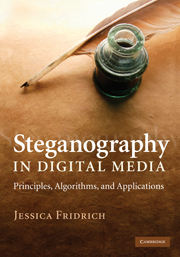Book contents
- Frontmatter
- Dedication
- Contents
- Preface
- Acknowledgments
- 1 Introduction
- 2 Digital image formats
- 3 Digital image acquisition
- 4 Steganographic channel
- 5 Naive steganography
- 6 Steganographic security
- 7 Practical steganographic methods
- 8 Matrix embedding
- 9 Non-shared selection channel
- 10 Steganalysis
- 11 Selected targeted attacks
- 12 Blind steganalysis
- 13 Steganographic capacity
- A Statistics
- B Information theory
- C Linear codes
- D Signal detection and estimation
- E Support vector machines
- Notation and symbols
- Glossary
- References
- Index
- Plate section
5 - Naive steganography
Published online by Cambridge University Press: 05 April 2014
- Frontmatter
- Dedication
- Contents
- Preface
- Acknowledgments
- 1 Introduction
- 2 Digital image formats
- 3 Digital image acquisition
- 4 Steganographic channel
- 5 Naive steganography
- 6 Steganographic security
- 7 Practical steganographic methods
- 8 Matrix embedding
- 9 Non-shared selection channel
- 10 Steganalysis
- 11 Selected targeted attacks
- 12 Blind steganalysis
- 13 Steganographic capacity
- A Statistics
- B Information theory
- C Linear codes
- D Signal detection and estimation
- E Support vector machines
- Notation and symbols
- Glossary
- References
- Index
- Plate section
Summary
The first steganographic techniques for digital media were constructed in the mid 1990s using intuition and heuristics rather than from specific fundamental principles. The designers focused on making the embedding imperceptible rather than undetectable. This objective was undoubtedly caused by the lack of steganalytic methods that used statistical properties of images. Consequently, virtually all early naive data-hiding schemes were successfully attacked later. With the advancement of steganalytic techniques, steganographic methods became more sophisticated, which in turn initiated another wave of research in steganalysis, etc. This characteristic spiral development can be expressed through the following quotation:
Steganography is advanced through analysis.
In this chapter, we describe some very simple data-hiding methods to illustrate the concepts and definitions introduced in Chapter 4 and especially Section 4.3. At the same time, we point out problems with these simple schemes to emphasize the need for a more exact fundamental approach to steganography and steganalysis.
In Section 5.1, we start with the simplest and most common steganographic algorithm – Least-Significant-Bit (LSB) embedding. The fact that LSB embedding is not a very secure method is demonstrated in Section 5.1.1, where we present the histogram attack. Section 5.1.2 describes a different attack on LSB embedding in JPEG images that can not only detect the presence of a secret message but also estimate its size.
Some of the first steganographic methods were designed for palette images, which is the topic of Section 5.2. We discuss six different ideas for hiding information in palette images and point out their weaknesses as well as other problematic issues pertaining to their design.
- Type
- Chapter
- Information
- Steganography in Digital MediaPrinciples, Algorithms, and Applications, pp. 59 - 80Publisher: Cambridge University PressPrint publication year: 2009
- 1
- Cited by



